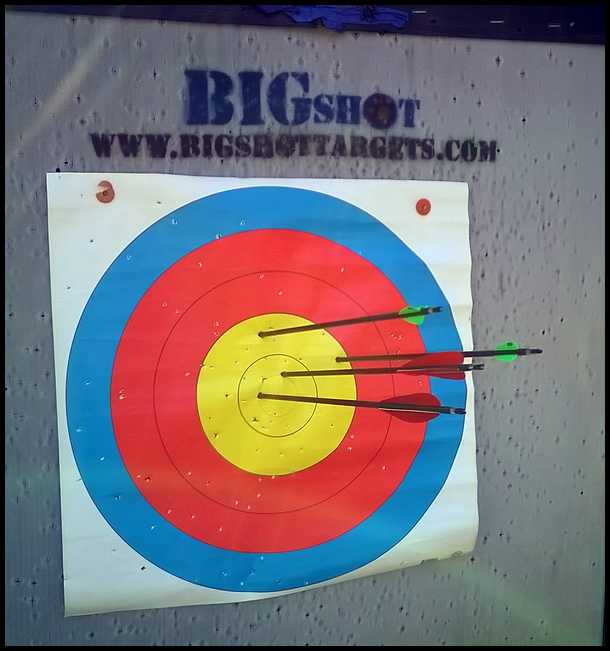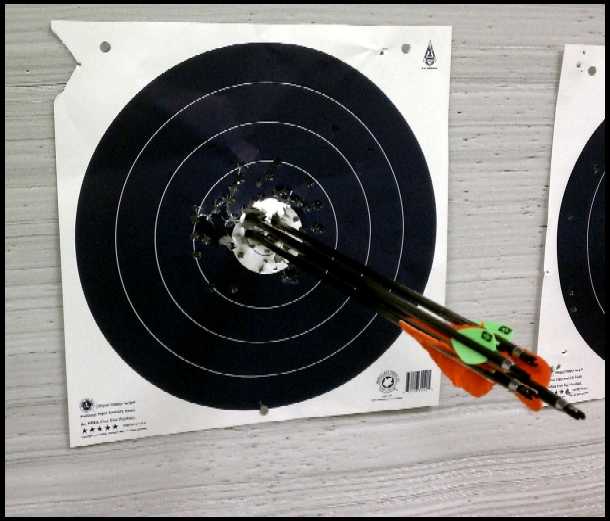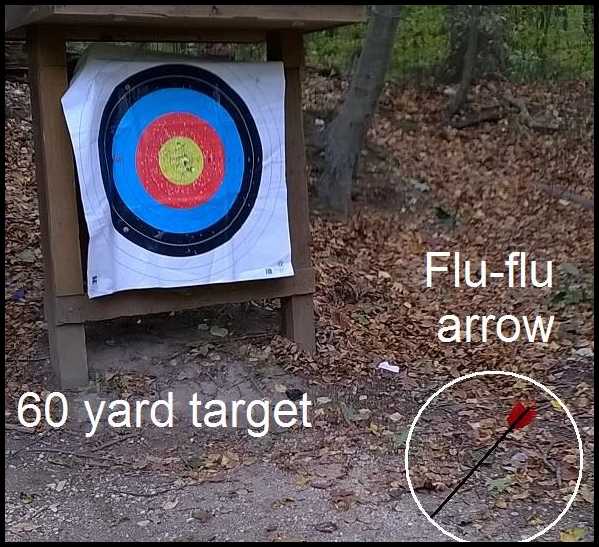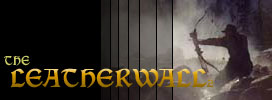| From: GF
|
|
|
|
|
|
|
| Date: 12-Mar-18 |
|
Question for the compulsive tuners...
OK....
A major advantage of a well-tuned arrow is that it’ll straighten up quickly with a minimum of steerage; doesn’t require those great big energy-robbing 5” helicals to fly right.
OK, fine....
But big brakes don’t slow you down much if you stay off of ‘em until they’re needed. There’s a difference between Unnecessary and outright Harmful.
So the question is, do you think that big fletchings add a meaningful or harmful amount of drag when the arrow settles quickly into point-on flight? No question there’s more there, but does it make a big difference, or only when it’s necessary to overcome a serious tuning issue in the first place???
|
|
| From: mountaineer
|
|
|
|
|
|
|
| Date: 12-Mar-18 |
|
At the distances most of us are comfortable taking a hunting shot...the larger fletchings won't rob any efficiency. I can see the argument if you're a field target archer.
At the low velocity we shoot (we meaning trad hunters), the loss of speed will be very minimal compared across fletching sizes, shapes, number so feathers, amount of helical, etc.
|
|
| From: GLF
|
|
|
|
|
|
|
| Date: 12-Mar-18 |
|
Depends on the amount of helical. A real hard helical with big feather can have a flu flu effect ,where straight will have very little effect.
|
|
| From: George D. Stout
|
|
|

|
|
|
|
| Date: 12-Mar-18 |
|
I shot some 1816 from a 40# bow with both 2" feathers that Bowmania sent me, and with 5" parabolic. Both left wing slight helical. With 2" fletch there isn't much helical anyway.
After shooting each of them at distance into my big bale at 55 yards, and averaging them, the 2" impacted on average about 5 inches higher at that 55 yards on average than did the 5" helical parabolic. So yes, a flatter trajectory. What does that mean at 20 yards, well it makes a difference of about 2" in that distance. How that applies to taking game is anyone's guess, but in real life I've found the bigger feathers penetrate very well and usually through to the other side.
It's good to know the difference of course, and for guys and gals using the lower weights, it would be of more significance to get a few more miles per gallon. It's said though that the best indicator of future performance is past performance, so in that light the bigger fletching will, and has worked just dandy. Again...it's mostly up to you and what you want.
|
|
| From: GF
|
|
|
|
|
|
|
| Date: 12-Mar-18 |
|
Good input, George - and I believe that you shoot well enough for those numbers to mean something...
Think I’m going to go w/Gary on this, though.... thinking that the degree of helical probably matters more than the inches of feather, but that means that there should be an intersection where X inches of helical produces the same amount of drag as Y inches of straight or Z inches of off-set...
The thing about better penetration from bigger fletchings, though...,
You can’t get straighter than straight, can you? At some point that extra stabilization has to become pure liability...
|
|
| From: 2 bears
|
|
|
|
|
|
|
| Date: 12-Mar-18 |
|
George it is good to see that you are experimenting and starting to see the advantages. You are right for the hunting distance that most of us hold to, it makes little difference. Some do shoot out to 50 or more yards. 5" or a mis judge of range 5 yards = a wound. Others like myself that have been forced to drop draw weight need/want every little advantage we can get in flattening the trajectory and penetration. Even the 2" could possibly make a big difference. Thanks for the test results and they are very similar to mine. Shoot what gives you confidence. >>>----> Ken
|
|
| From: ny yankee
|
|
|
|
|
|
|
| Date: 12-Mar-18 |
|
Yes there is a difference between unnecessary and harmful. I shoot large helical feathers, big fat bendy wood shafts and big fat stretchy strings but you know what? It works for me and I still hit what I want to and I still knock the block over when my arrow hits it. So what does that tell us? Unnecessary? Maybe. Harmful? For what? Gettin' the job done and I like it that way.
|
|
| From: Viper
|
|
|
|
|
|
|
| Date: 12-Mar-18 |
|

Mr. Stout -
Like this? OK, 60 yds, and IIRC, Vo was about 190 fps.
Guys - Unless you get to flu-flu territory, yes, there is a difference, but it really ain't much.
Viper out.
|
|
|
|
| From: Jim
|
|
|

|
|
|
|
| Date: 12-Mar-18 |
|
Stir it up again, LOL.
|
|
| From: 2 bears
|
|
|
|
|
|
|
| Date: 12-Mar-18 |
|
Viper I respect your knowledge and love your book I recommend it to everyone. That target sure doesn't agree with George's and my findings?? There was another thread on here with quite a bit of testing. It seems he shot each fletch in 3 flights of 10. I seem to recall he had a little more difference than George and I did. Is it possible you may have fudged a bit-even subconsciously? If not, Wow we can even mix them up in the quiver.Olympic archers could stay in the gold. No need for matched arrows.>>>----> Ken
|
|
| From: Viper
|
|
|
|
|
|
|
| Date: 12-Mar-18 |
|
Batman -
Yes, but not as much as you think. Increased air resistance will help with very minor form flaws, but you can't have a real pluck or bow torque and expect the fletch to fix that. In fact, increase air resistance may benefit a better shooter more than a less consistent one. And you gotta go pretty heavy to get into flu-flu territory.
Viper out.
|
|
| From: Viper
|
|
|
|
|
|
|
| Date: 12-Mar-18 |
|

kodiaktd --
In response to your PM, I don't have a pic at 30 yards, but here's one at 20. Same arrows.
BTW - the key factor is that all arrows have the exact same weight.
And for the record: those shots all came from an Olympic bow (with a sight).
Viper out.
|
|
| From: Kodiaktd
|
|
|
|
|
|
|
| Date: 12-Mar-18 |
|
Thanks Viper. I appreciate it.
|
|
| From: Bowmania
|

|
|

|
|
|
|
| Date: 12-Mar-18 |
|
Viper, I assume those were shot at 20 and with a sight. The problem, as I see, it is you have plastic and feathers. When you do an experiment you only change one variable.
My difference in impacts was around 4 inches at 22 yards. A lot closer to what David McLendon found. I think if I was shooting at 55 yards, I don't think I could come up with an exact difference. I'm not good enough, even though my point on is 62 yards. I was shooting a 50 pound bow, so go figure, I have almost as much difference at 22 that a 40 pound bow had at 55. I'd think a 40 pound bow would have been more difference that 50?
When it comes to hunting at 20 yards I don't think that even my 4 inch difference makes much difference. You get used to shooting that difference. Practice (it is easier to shoot with flatter trajectory any way you look at it). I think the real difference is noise. Five inch feathers have 15 inches of feathers. Two inch have 6 (3X5=15 and 3X2=6)
Stand into the wind with a 5 mile and hour wind. You can hear the that wind in your ear. Now increase the wind to 25 mph. The wind is resisting going past your ear. 25 MPH is louder.
Now let's go to an arrow and leave the feet per second the same, but increase the resistance from 6 to 15. THat five inch feather is going to be twice as loud at least. Might not sound a lot to us, but we don't have ears the size of a deer and the arrow is not shot AT us.
Bowmania
|
|
| From: Scoop
|

|
|
|
|
|
|
| Date: 12-Mar-18 |
|
|
|
| From: Scoop
|

|
|
|
|
|
|
| Date: 12-Mar-18 |
|
Sorry on the blank post. I appreciate it, too, Viper.
|
|
| From: Viper
|
|
|
|
|
|
|
| Date: 12-Mar-18 |
|

Ken -
No, a "fudge factor" isn't possible due to the type of bow (sight and clicker), and frankly, my shooting ability. The only differences between my results and yours may be due to the speed (and type) of arrows. Can't account for every combination out there.
A real flu-flu, even with an elevation "fudge factor" barely reaches 60 yards.
Viper out.
|
|
| From: 2 bears
|
|
|
|
|
|
|
| Date: 12-Mar-18 |
|
O.K. viper if you say so. David McLendon was the man I couldn't recall. Good catch Bomania. Vanes are heavier than feathers. I wonder if there could be other differences. David's test as well as mine were with identical arrows except for the fletches. I believe George's were also. Tony don't make me go to your book. LoL ;^) seriously I am puzzled by this and always willing to learn. I shoot 3X5" on self bows for looks and a lot of 2 fletch for fun. I generally don't go for less than 3X4" for a little safety margin when hunting. I believe 3X3" would be more than sufficient. Like the DIY fletching thread. I can do it any way I want, to experiment and save feathers.Have fun out there. >>>----> Ken
|
|
| From: Kodiaktd
|
|
|
|
|
|
|
| Date: 12-Mar-18 |
|
According to Lancaster:
5” length fletching; 0.649" height. Average weight is 3.63 gr.
East Diamond VANES EMBOSSED WITH THE EASTON LOGO AVAILABLE SIZES: SIZE LENGTH HEIGHT 175(2.6gr.) 1 3/4 .375 235(4.0gr.) 2 3/8 .355
I'm sure different profiles and manufacturer's vanes and feathers may vary some in weight.
|
|
| From: Viper
|
|
|
|
|
|
|
| Date: 12-Mar-18 |
|
Ken -
Some times what we (want to) believe and our own experiences don't quite line up.
There is a point where so much fletch is added to the tail of the arrow that speed/cast or just distance is affected. That's what we call a flu-flu ;).
If the fletch caused as much drag and changes in point of impact as suggested, then bare shaft tuning beyond spitting distances would be impossible - right?
No matter how small or how straight a feather is used, it will still provide more resistance than no feathers. And people do bare shaft tune vs. 5" feathers with a good amount of helical.
Viper out.
|
|
| From: longbowguy
|
|
|
|
|
|
|
| Date: 13-Mar-18 |
|
Most of you boys are guessing, and not very well. George and Viper are not; they have done some testing. So have I.
My conclusion is that if the arrows are reasonably well matched to the bow there is not much difference between various sizes of feather and of plastic vanes out to about 40 yards.
If the arrows are not well matched to the bow, or if you short draw under stress, larger fletching and more helical may actually stabilize the arrow more quickly so it carries farther and higher for a considerable distance.
For hunting distances, and if you do not short draw, all of that matters little. I hunt with large fletching to straighten the arrow out quickly in case I need to fit it between saplings, and so I can see in dim light whether or not I made a good hit. - lbg
|
|
| From: 2 bears
|
|
|
|
|
|
|
| Date: 13-Mar-18 |
|
Very good point Viper. I believe in giving credit where credit is due. That doesn't explain our tests though. In fact David was not bias toward the small feathers. He was trying to find out how much fletching it would take to lower his point on to the shorter distance he wanted. He accomplished that with bigger fletches. It agrees with my testing. Smaller feathers are less bothered by the wind and quieter too. That is the conclusion of personal testing also. One more thought I have never seen 5" fletches with helix on the Olympic line. They don't want wind deflection,and higher trajectories. Less flight time would be an advantage also. What am I missing here? Over and Out. >>>----> Ken
|
|
| From: Bob Rowlands
|
|
|
|
|
|
|
| Date: 13-Mar-18 |
|
At the close range I shoot, there's no's noticeable difference in velocity between 3- 5.5" fletch and 4 of the same size. That's a non issue as far as I am concerned. I shoot heavier arrows well above the 10gpp range and an extra feather doesn't visibly effect their speed or trajectory. Remember I shoot close range though. Twenty five yards is a long shot for me.
What IS very visible is how quickly four fletch arrows straighten up in flight, in comparison to standard three fletch. It's amazing just how quickly they straighten out, and continue to fly straight. It's like watching tracers.
Any average archer that doesn't have great form every shot - that's me- can see this. The typical trad shooter that takes a few dozen shots in a row of 3 and 4 fletch will easily see a difference.
I'd shoot 4 fletch all the time but I just can't stand how they look. I'm way too much of a traditionalist to let that slide. I just gotta have three feathers and that is that. If I was making replica self arrows I'd probably even fletch two, tied on paleo style.
|
|
| From: Kodiaktd
|
|
|
|
|
|
|
| Date: 13-Mar-18 |
|
X2 with Viper. Good point Viper.
|
|
| From: Jim Keller
|
|
|
|
|
|
|
| Date: 13-Mar-18 |
|
I read David's post and started to reply but then thought to stay out of it. But Vipers response hit on what I was thinking( and I'm not trying to stir the pot, these are the thoughts I had).
If a bow is properly tuned and bare shafts are hitting the same as fletched, why would putting on 2" feathers make them fly high? Going by that logic, bare shafts should fly higher than 2" correct?
I don't doubt the results, just don't understand. Jim
Ive had other questions you guys have cleared up for me. So I'm sure there's an explanation I'm just not getting through my head.
These discussions are very interesting. Thanks, Jim
|
|
| From: Skeets
|
|
|
|
|
|
|
| Date: 13-Mar-18 |
|
Do you want your arrows to impact straight at 10, 15, and 20 yards? Even with a less than perfect release during a hunting situation. How about when it rains and the feathers are wet and matted down some? I'll stick with the larger helical fletch.
Viper's examples are as good as you will ever get for eliminating variables of sighting and draw length and weight.
|
|
| From: Rick Barbee
|
|
|
|
|
|
|
| Date: 13-Mar-18 |
|
I'd bet dollars to a hole in a doughnut, that all things being equal, except the fletching:
a perfectly tuned, and (perfectly shot) 1" fletched arrow will outdistance a perfectly tuned & (perfectly shot) 5" fletched arrow in a flight competition.
Those flight shooting guys know what they are doing.
There's a reason why they use small fletchings, and it ain't because they want to look dainty. :-)
Rick
|
|
| From: GF
|
|
|
|
|
|
|
| Date: 13-Mar-18 |
|
Well, Rick... if you're waiting for someone to take up that argument with you, I hope you brought snacks! LOL
“Most of you boys are guessing, and not very well. George and Viper are not; they have done some testing. So have I. My conclusion is that if the arrows are reasonably well matched to the bow there is not much difference between various sizes of feather and of plastic vanes out to about 40 yards.
If the arrows are not well matched to the bow, or if you short draw under stress, larger fletching and more helical may actually stabilize the arrow more quickly so it carries farther and higher for a considerable distance.”
Hmmm....
How about this thought: your assumption appears to be that an arrow that straightens up over a short distance requires less total drag applied to do the work of settling out that imperfect flight with lower net loss of velocity. Not talking about the oscillations of the shaft here (due to flexing around the riser), but the tail-wagging that comes from incorrect spine or a flawed release. Not talking penetration here, either - just the trajectory piece.
So the question is, do fewer, more forceful corrections add up to More or Less total drag applied than a larger number of smaller inputs?
|
|
| From: Rick Barbee
|
|
|
|
|
|
|
| Date: 13-Mar-18 |
|
[[[ So the question is, do fewer, more forceful corrections add up to More or Less total drag applied than a larger number of smaller inputs? ]]]
I say: "Fewer, more forceful corrections add up to more drag."
But, that's just "my opinion" after spending pretty much a lifetime of trying to squeeze every bit of speed, and delivered energy of the arrow, that I can get out of my equipment.
"Obviously" it's give & take, because you have to determine just how small you can go with the fletching before it stops compensating for flaws in both your tuning & shooting abilities.
Rick
|
|
| From: GF
|
|
|
|
|
|
|
| Date: 13-Mar-18 |
|
I'm inclined to agree with you if for no other reason than that once the heavier fletchings have done their corrective work, they just sit back there holding up the show... And in other activities where Speed is King, you're generally better off making several small corrections than one big one.
Too, when you watch the Ken Beck bare-shaft videos of arrows "swimming" all the way to the target, it becomes clear that most arrows spend relatively little time lined up straight down the range, so with every oscillation, you're presenting more of the fletching's profile, which ups the ante to some degree...
Good news for Heavy Arrow guys is that drag increases exponentially with speed, so the slower you start out the slower you shed speed... it's harder for those of us trying to squeeze out more velocity from a shorter DL.... Just can't catch a break!
|
|
If you have already registered, please sign in now
For new registrations Click Here
|
|
|
|



